| Author |
Message |
|
Ivo Malz
Location: Hanau, Germany Joined: 08 Jan 2005
Posts: 30
|
 Posted: Mon 24 Jan, 2005 12:40 pm Post subject: Posted: Mon 24 Jan, 2005 12:40 pm Post subject: |
 |
|
Hello.
This is my first entry on this forum, so I´d like to introduce myself while I am at it. My name is Ivo Malz, I am German and co- founder of a small Living History group named "Löwe und Schwan". Our focus currently is mainly on getting our stuff together, a website is in the making. One of our projects is to build two pavises.
Two things as to further entries: Roman scuta, judging from the few extant examples from Dura europos and another location the name of which I can not remember, were constructed of a sort of plywood, consisting of three layers of thin wooden slats glued to one another. The outer one runs vertically, the middle one horizontally, the inner one vertically again. Pavises, as far as I know, were constructed rather of planks than in the "early plywood way".
As to damar: Damar is a natural resin that can be used for the preparation of a transparent, lacquer- like varnish.
What bothers me most in my research is that almost any article dealing with pavises strongly focuses on the style of the painted surfaces, heraldic questions and questions of superstition for the "ihc" for a short period in the late 15th century was all the rage. Unfortunately the wooden construction is only described as to consist of...wood.
There actually is but one article I came across that actually dealt with the painting, the materials and techniques used in the manufacture of a pavise. It comes from a 1977 catalogue on an exhibition held at Schloss schallaburg in Austria for which the 68 pavises from the Vienna arsenal had been restored.
The second best source is an A5 leaflet from the wartburg in Germany. which is a reprint of parts of a catalogue that was written some time in the 1920 (The Wartburg Collection is gone since 1946 when the Russians captured it, the only remaining items are a close helmet and a 16th century boy´s armour).
***
Contents of the Schallaburg catalogue:
Wooden core ("generally soft wood"), both sides faced with glued- on parchment/rawhide and/or linen. Means: Some were covered completely in parchment, others in parchment on the inside only with the outside in linen, some covered completely in linen.
Linen covered in several layers of gesso.
Some had the central field covered in silver leaf and subsequently polished. Painting on silver leaf in black tempera, "resembling a woodcut". Some feature opaque highlights in yellow or white. If colours were used on the silver field, these were "Lüster", that is, transparent varnishes that used the luster of the silver to enhance the colours.
Last step was the painting of the borders in opaque ("fat") egg tempera directly onto the gesso which sometimes got a limewash treatment aforehand.
Other pavises without a silver leaf field were completely painted in egg tempera.
The insides of the pavises generally received but a thin layer of gesso painted in "Leimfarbe" which is a glue- based paint consisting of glue, gypsum and pigments
The entire surface was then sealed by a not specified tarnished "varnish"
Interesting detail: The silver leaf pavises show signs of battle wear, too.
***
Information from the Wartburg leaflet:
Types of wood mentioned are fir an beech. No further informations as to the paints, the rawhide/parchment covering of the inside (and sometimes the outside, too) which seems to be the rule is in this case being referred to as "leather".
***
So here are my questions, gentlemen, has any of you better information as to the types of wood? Usually limewood is considered THE wood for shields as is ash for polearms, box for knife handles and yew for longbows.The Marburg heater shields Jan Kohlmorgen is dealing with, if memory serves, were as a rule made of limewood. The Schallaburg catalogue speaks of "soft woods" to be the rule as opposed to the beech mentioned in the Wartburg catalogue. Willow and poplar have been used for shields, alder is mentioned by Kohlmorgen.
From an engineering perspective on the one hand poplar and willow seem unreasonable for being too soft, thus speak the live steel fighters. But on the other hand in pavises the wood is covered in hide and/or linen, the linen soaked in glue acting sort of like the modern glassfiber/carbonfiber and resin reinforcements used on modern wooden bowstaves. Which in turn do nothing but imitate the ancient hide or sinew reinforcements. So even the use of fir seems reasonable at least, whereas the use of beech collides with this idea for beech is hardwood and pretty heavy, whereas pavises were designed for swift mobility.
Can anyone of you help me any further in this question and provide me with less out- dated information as to the types of wood used in pavises?
Thanks in advance and best regards,
Ivo
|
|
  |
 |
|
Thomas James Hayman
Location: England Joined: 08 Dec 2004
Posts: 30
|
 Posted: Sat 12 Mar, 2005 2:54 pm Post subject: Posted: Sat 12 Mar, 2005 2:54 pm Post subject: |
 |
|
|
I've talked to Ivo on this a couple of times and fir was a popular wood to use. strong yet relatively light. My pavise in fir has turned out perfectly. i plan on 'testing' it in a few months.
|
|
 |
 |
|
Martin Koehler
Location: Great Falls, MT Joined: 09 May 2006
Posts: 2
|
 Posted: Tue 09 May, 2006 10:52 am Post subject: Posted: Tue 09 May, 2006 10:52 am Post subject: |
 |
|
| Thomas James Hayman wrote: | | I've talked to Ivo on this a couple of times and fir was a popular wood to use. strong yet relatively light. My pavise in fir has turned out perfectly. i plan on 'testing' it in a few months. |
Greetings,
i'm new to the forum, and i'm interested in how the pavise is working for you and also Ivo is there a place where there might be a tutorial with pictures on how to make one of the hand pavise??
Martin
|
|
  |
 |
|
Thomas James Hayman
Location: England Joined: 08 Dec 2004
Posts: 30
|
 Posted: Tue 09 May, 2006 12:46 pm Post subject: Posted: Tue 09 May, 2006 12:46 pm Post subject: |
 |
|
Hi there, nothing like a tutorial yet. Still got to make some more and see how things go. Have been researching mostly and digging around. Ivo being in Germany, not sure what he's up to :-)
I should be posting some kind of article on constructing the larger type within the year but not putting a date as things always come up.
|
|
 |
 |
Nathan Robinson
myArmoury Admin


|
 Posted: Mon 26 Jun, 2006 12:04 am Post subject: Posted: Mon 26 Jun, 2006 12:04 am Post subject: |
 |
|
A Fine and Rare Bohemian Pavise, Zwickau, circa 1480
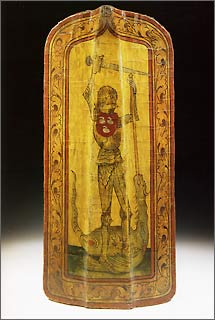
Click for detailed version
Of rectangular shape with rounded corners and a medial gutter of angular section narrowing slightly to a projecting 'beak' at the top; and formed of wood covered with gessoed canvas. The front painted in golden brown, red, green and black on a white ground with a representation of St George in a 'Gothic' armour fighting a dragon with a sword in his right hand, a spear in his left hand and a small shield bearing the arms 'gules, three swans argent' suspended at his neck, within a border of scrolling foliage and flowerheads. Fitted at the rear are the remains of a carrying handle and straps.
Overall height: 50 in; Overall width: 23 in
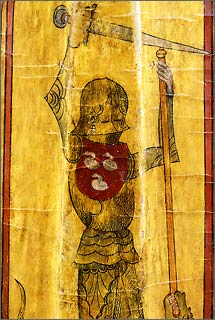
Click for detailed version
The pavise is thought to have taken its name from the North Italian city of Pavia where it perhaps originated. Of oblong form, usually with a medial gutter running down its rear, its use by archers and other classes of infantry extended from the late 14th century to the early 16th century. Although some of its kind were no more than hand-held shields, others, like that shown here, were of a sufficient size to allow them to be propped up in front of the crossbowman to provide him with temporary shelter while he spanned and loaded his weapon.
Both types of pavise are clearly depicted in the fine woodcuts prepared by Hans Burgkmair between 1512 and 1518 for the Triumph of Maximilian I. According to the Emperor's carefully dictated instructions for these woodcuts, the five men shown carrying the larger pafessen were to be dressed and armed in the Hungarian manner, suggesting that the use of such shields was particularly associated with Eastern Europe.
The use of the larger form of pavise by the crossbowman is well shown in the Pageant of the Birth, Life and Death of Richard Beauchamp Earl of Warwick of about 1485-90 in the British Library, London. In accordance with the tastes of the later Middle Ages, pavises tended to be decorated with a colorful design that typically involved the arms of the town or city for which they were made.
The arms on the present splendid example show it to have formed a part of the armoury of the Bohemian town of Zwickau, located in the Lausitzer Mountains, just to the west of the present German border. A pavise from the same series is preserved in the Royal Armouries Museum, Leeds (Inv. No. V.I) together with two others (Inv. Nos V. 2 & V.I3) bearing the same arms but showing a different design. One of the latter is of large size, while the other is of small size.
Other pavises bearing the arms of Zwickau can be found in the Metropolitan Museum of Art, New York (Ace. No. 29. 158.595), the Philadelphia Museum of Art (Cat. Nos. 274, 281, & 282), the Museum fur Deutsche Geschichte, Berlin (Inv. No. P.C.8967), as well as the Kunstsammlung der Veste Coburg and the Hermitage Museum, St. Petersburg. As these are of varying sizes, shapes and designs, it is likely that they were purchased at different periods. The finely rendered ' Gothic' armour worn by the figure of St. George that forms the central feature of the design of the present pavise shows it to date from about 1480.
Photos and Text Copyright © 2004 Peter Finer
.:. Visit my Collection Gallery :: View my Reading List :: View my Wish List :: See Pages I Like :: Find me on Facebook .:.
|
|
    |
 |
Nathan Robinson
myArmoury Admin


|
 Posted: Mon 26 Jun, 2006 3:00 am Post subject: Posted: Mon 26 Jun, 2006 3:00 am Post subject: |
 |
|
A Bohemian Pavise, circa 1430-40
Wood, iron; oil paints
State Hermitage Museum, St Petersburg; Inventory number: Z.O. 6090
From the former Tsarkoe Selo Arsenal; previously in A. P. Bazylevsky's collection until 1884.
Overall height: 56 1/4 in
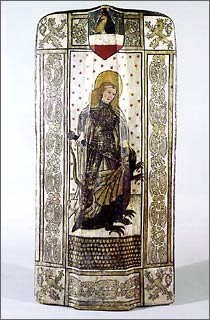
Click for detailed version
The shield is composed of wood planks. The surface is covered with linen. An image of St. George killing a dragon is painted on it. In the four corners we have a heraldic lion with split tail (Bohemia's coat of arms) and the coat of arms belonging to the town of Enns. It is assumed that the shield comes from 1437 when the prince of Austria, Albrecht V Habsburg [d. 1439] inherited the Bohemian crown. Similar shields, used for protecting archers, appeared in Europe in the 13th century and were dubbed as the Pavise shields, after the Italian town of Pavia. The most impressive shields were used during the Hussite wars in the 15th century.
Photos and Text Copyright The National Hermitage Museum
.:. Visit my Collection Gallery :: View my Reading List :: View my Wish List :: See Pages I Like :: Find me on Facebook .:.
|
|
    |
 |
|
Felix Wang
|
 Posted: Mon 26 Jun, 2006 2:48 pm Post subject: Posted: Mon 26 Jun, 2006 2:48 pm Post subject: |
 |
|
|
Beautiful works of art. Still, I do wish that a few more pictures of the back of pavises were available, and minor details like the thickness and weight (sigh).
|
|
  |
 |
Nathan Robinson
myArmoury Admin


|
 Posted: Mon 26 Jun, 2006 2:53 pm Post subject: Posted: Mon 26 Jun, 2006 2:53 pm Post subject: |
 |
|
| Felix Wang wrote: | | Beautiful works of art. Still, I do wish that a few more pictures of the back of pavises were available, and minor details like the thickness and weight (sigh). |
I agree. I'd love to see more details of the backside with attention paid to the strapping and functional aspects of these things.
I suspect this photo is only available because it has artwork/painting on the reverse side. 
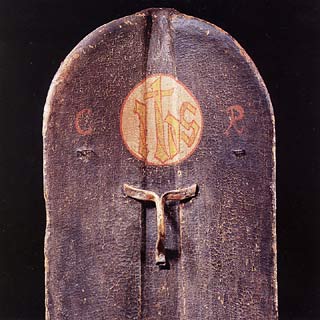
Click for detailed version
.:. Visit my Collection Gallery :: View my Reading List :: View my Wish List :: See Pages I Like :: Find me on Facebook .:.
|
|
    |
 |
|
Thomas James Hayman
Location: England Joined: 08 Dec 2004
Posts: 30
|
 Posted: Mon 26 Jun, 2006 4:02 pm Post subject: Posted: Mon 26 Jun, 2006 4:02 pm Post subject: |
 |
|
This one belonged to Matthius Corvinus and is haoused in the Musee De L'armee.
Within the next couple of years, i hope to have collated and updated some previous research on pavises with some finer details like materials and sizes included. be very patient and you'll be happy chappies.
 Attachment: 71.88 KB Attachment: 71.88 KB
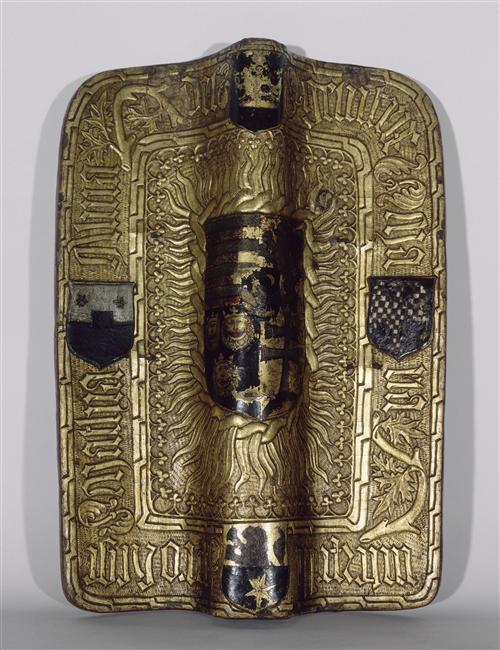
 Attachment: 57.26 KB Attachment: 57.26 KB
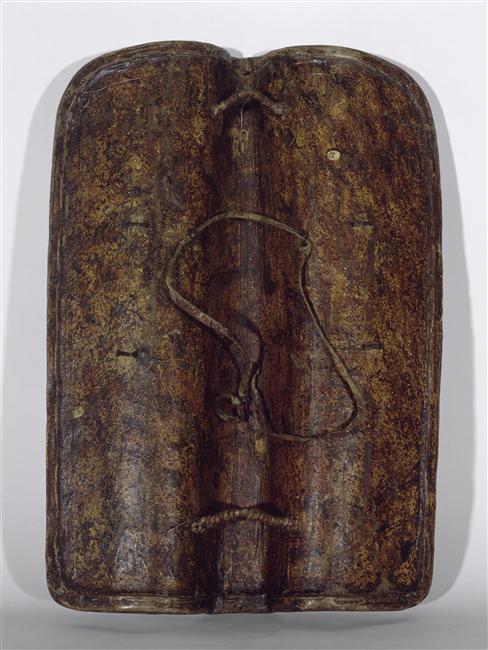
|
|
 |
 |
|
Felix Wang
|
 Posted: Mon 26 Jun, 2006 5:06 pm Post subject: Posted: Mon 26 Jun, 2006 5:06 pm Post subject: |
 |
|
Thomas:
That is a very interesting pavis back. There are two horizontal straps, top and bottom, and then this larger, looser strap in the middle. This last loop seems to run through two small eyelets in the upper corners (still the middle of the shield) and a larger attachment at the bottom.
How do you think these straps were used? The top and bottom are very near the edge of the shield for arm and hand grips (and I am not sure how big the shield is). The central loop wouldn't normally have those extra eyelets for a guige, either.
|
|
  |
 |
|
Thomas James Hayman
Location: England Joined: 08 Dec 2004
Posts: 30
|
 Posted: Tue 27 Jun, 2006 2:45 pm Post subject: Posted: Tue 27 Jun, 2006 2:45 pm Post subject: |
 |
|
To be honest, without seeing the shield and the various sizes of the strapping, i couldn't say. from the photo, i'd see it as the hand gripping the larger of the two end straps with the loose strap going over the arm. Used in a manner similar to a buckler, as seen in period illustrations, such as this:
(It would appear i have lost the image. It is in black and white and Triumph of Maximillian rings a bell, will search tommrow and post it.
|
|
 |
 |
|
Carl Scholer
|
 Posted: Wed 28 Jun, 2006 12:32 pm Post subject: Posted: Wed 28 Jun, 2006 12:32 pm Post subject: |
 |
|
|
Does any one know how heavy or how thick some of these pavises are. I was able to find the weight of one in the catalog of a museum along with its dimensions and compared it to a Roman scutum and found that the pavise had the same weight per square foot of surface area. I was surprised because I had always thought of pavises as being much thicker and heavier than shields of antiquity and the early middle ages.
|
|
  |
 |
|
Thomas James Hayman
Location: England Joined: 08 Dec 2004
Posts: 30
|
 Posted: Wed 28 Jun, 2006 1:08 pm Post subject: Posted: Wed 28 Jun, 2006 1:08 pm Post subject: |
 |
|
|
Some of the pavises made to sit on the ground weighed anything from 7kg to around 10+kg. this varies obviously upon material and the covering. The smaller hand held version weigh around 5kg (only one measurements for those, thoguh)
|
|
 |
 |
|
William Knight
Location: Mid atlantic, US Joined: 02 Oct 2005
Posts: 133
|
 Posted: Sat 26 Aug, 2006 9:13 pm Post subject: Posted: Sat 26 Aug, 2006 9:13 pm Post subject: |
 |
|
Where does the popularity (in central europe at least) of the Pavise fit into in terms of the general decline of the use of the (non-buckler) shield? What was the primary purpose of (smaller) hand pavises, particuarly, which seem unsuited to the anti-missile/field fortification use of the big ones?
-Will
|
|
  |
 |
|
M. Johnston
Location: Bangor, Maine Joined: 03 Oct 2006
Posts: 7
|
 Posted: Tue 03 Oct, 2006 11:19 am Post subject: Posted: Tue 03 Oct, 2006 11:19 am Post subject: |
 |
|
| Thomas James Hayman wrote: | To be honest, without seeing the shield and the various sizes of the strapping, i couldn't say. from the photo, i'd see it as the hand gripping the larger of the two end straps with the loose strap going over the arm. Used in a manner similar to a buckler, as seen in period illustrations, such as this:
(It would appear i have lost the image. It is in black and white and Triumph of Maximillian rings a bell, will search tommrow and post it. |
is this it?
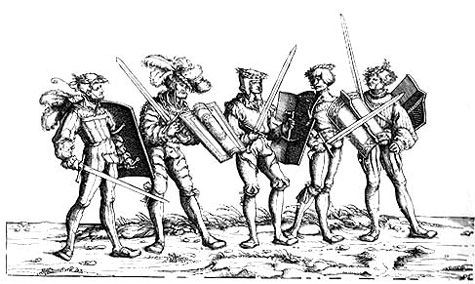
I found these forums a month or so back through a search for information on building a pavise, and have been been lurking and reading since then.
|
|
   |
 |
|
Thomas James Hayman
Location: England Joined: 08 Dec 2004
Posts: 30
|
 Posted: Tue 03 Oct, 2006 11:23 am Post subject: Posted: Tue 03 Oct, 2006 11:23 am Post subject: |
 |
|
That's actually not it, but a cracking image none the less!!
Good luck on finding any kind of instructional site on building one. there aren't any. If you need any help, i'd be happy to send along photos of the one i've nearly done.
|
|
 |
 |
|
Jon Cooper
Location: Lilnlithgow Joined: 01 Dec 2006
Posts: 3
|
 Posted: Fri 01 Dec, 2006 1:51 pm Post subject: Pavises at Flodden Posted: Fri 01 Dec, 2006 1:51 pm Post subject: Pavises at Flodden |
 |
|
Help required
I've been researching the arms and equipment of the Scots at Flodden and their use of Pavises- I see a number of wargame figure manufacturers supply pavises consisting of two wooden boards butted together at an angle as shown below - any ideas as to the precedence for this design - they seem too big and too unwieldy to have been effective. However as this may be the only time the Scots used pavises in earnest then can I assume they were somewhat unorthodox in design.
 Attachment: 2.04 KB Attachment: 2.04 KB

|
|
  |
 |
|
Thomas James Hayman
Location: England Joined: 08 Dec 2004
Posts: 30
|
 Posted: Fri 01 Dec, 2006 3:16 pm Post subject: Posted: Fri 01 Dec, 2006 3:16 pm Post subject: |
 |
|
Honestly, the only reference to pavises being made in this country (and i can't be too sure of their shape) is from the falstoff inventory.
PETITION TO HENRY VI Before 1449, 07, 16
Januarij last past the seid lord sent to the seid mansion a riotous peple to the nombre of a thowsand persones, with blanket bendes of a sute as riseres a-geyn your pees, arrayd in maner of werre with curesse, brigaunderes, jakkes, salettes, gleyfes, bowes, arows, pavyse, gonnes, pannys with fier and teynes brennyng there-in.
Also : INVENTORY AND INDENTURE: DRAFT 1462, 06, 06
..... Item, xxiiij paveyz of elm bord, ij of baleyn.
I've never found a refernce to pavises used at Flodden or Scotland.
|
|
 |
 |
|
Jon Cooper
Location: Lilnlithgow Joined: 01 Dec 2006
Posts: 3
|
 Posted: Sat 02 Dec, 2006 2:57 am Post subject: Posted: Sat 02 Dec, 2006 2:57 am Post subject: |
 |
|
Thank you Thomas
Direct reference to Pavises at Flodden is made in a letter from thomas Ruthal Bishop of Durham to Thomas Wolsey dated 20th September 1513 ' The said scots were so surely harnessed with complete harness, german jacks, rivets, splents, pavises and other habilments that shot of arrows in regard did them no harm....
What is of particular interest to me is why the unusual cobbled together design ?
|
|
  |
 |
|
Thomas James Hayman
Location: England Joined: 08 Dec 2004
Posts: 30
|
 Posted: Sat 02 Dec, 2006 3:50 am Post subject: Posted: Sat 02 Dec, 2006 3:50 am Post subject: |
 |
|
OO, cool!!
As i'm sure you know, going off of wargaming figures can be a little misleading. Why they appear so cobbled together, i don't know!
|
|
 |
 |
|
|
You cannot post new topics in this forum
You cannot reply to topics in this forum
You cannot edit your posts in this forum
You cannot delete your posts in this forum
You cannot vote in polls in this forum
You cannot attach files in this forum
You can download files in this forum
|
All contents © Copyright 2003-2025 myArmoury.com — All rights reserved
Discussion forums powered by phpBB © The phpBB Group
Switch to the Basic Low-bandwidth Version of the forum
|

